9.2: Inscribed angle
- Page ID
- 23634
\( \newcommand{\vecs}[1]{\overset { \scriptstyle \rightharpoonup} {\mathbf{#1}} } \)
\( \newcommand{\vecd}[1]{\overset{-\!-\!\rightharpoonup}{\vphantom{a}\smash {#1}}} \)
\( \newcommand{\dsum}{\displaystyle\sum\limits} \)
\( \newcommand{\dint}{\displaystyle\int\limits} \)
\( \newcommand{\dlim}{\displaystyle\lim\limits} \)
\( \newcommand{\id}{\mathrm{id}}\) \( \newcommand{\Span}{\mathrm{span}}\)
( \newcommand{\kernel}{\mathrm{null}\,}\) \( \newcommand{\range}{\mathrm{range}\,}\)
\( \newcommand{\RealPart}{\mathrm{Re}}\) \( \newcommand{\ImaginaryPart}{\mathrm{Im}}\)
\( \newcommand{\Argument}{\mathrm{Arg}}\) \( \newcommand{\norm}[1]{\| #1 \|}\)
\( \newcommand{\inner}[2]{\langle #1, #2 \rangle}\)
\( \newcommand{\Span}{\mathrm{span}}\)
\( \newcommand{\id}{\mathrm{id}}\)
\( \newcommand{\Span}{\mathrm{span}}\)
\( \newcommand{\kernel}{\mathrm{null}\,}\)
\( \newcommand{\range}{\mathrm{range}\,}\)
\( \newcommand{\RealPart}{\mathrm{Re}}\)
\( \newcommand{\ImaginaryPart}{\mathrm{Im}}\)
\( \newcommand{\Argument}{\mathrm{Arg}}\)
\( \newcommand{\norm}[1]{\| #1 \|}\)
\( \newcommand{\inner}[2]{\langle #1, #2 \rangle}\)
\( \newcommand{\Span}{\mathrm{span}}\) \( \newcommand{\AA}{\unicode[.8,0]{x212B}}\)
\( \newcommand{\vectorA}[1]{\vec{#1}} % arrow\)
\( \newcommand{\vectorAt}[1]{\vec{\text{#1}}} % arrow\)
\( \newcommand{\vectorB}[1]{\overset { \scriptstyle \rightharpoonup} {\mathbf{#1}} } \)
\( \newcommand{\vectorC}[1]{\textbf{#1}} \)
\( \newcommand{\vectorD}[1]{\overrightarrow{#1}} \)
\( \newcommand{\vectorDt}[1]{\overrightarrow{\text{#1}}} \)
\( \newcommand{\vectE}[1]{\overset{-\!-\!\rightharpoonup}{\vphantom{a}\smash{\mathbf {#1}}}} \)
\( \newcommand{\vecs}[1]{\overset { \scriptstyle \rightharpoonup} {\mathbf{#1}} } \)
\( \newcommand{\vecd}[1]{\overset{-\!-\!\rightharpoonup}{\vphantom{a}\smash {#1}}} \)
\(\newcommand{\avec}{\mathbf a}\) \(\newcommand{\bvec}{\mathbf b}\) \(\newcommand{\cvec}{\mathbf c}\) \(\newcommand{\dvec}{\mathbf d}\) \(\newcommand{\dtil}{\widetilde{\mathbf d}}\) \(\newcommand{\evec}{\mathbf e}\) \(\newcommand{\fvec}{\mathbf f}\) \(\newcommand{\nvec}{\mathbf n}\) \(\newcommand{\pvec}{\mathbf p}\) \(\newcommand{\qvec}{\mathbf q}\) \(\newcommand{\svec}{\mathbf s}\) \(\newcommand{\tvec}{\mathbf t}\) \(\newcommand{\uvec}{\mathbf u}\) \(\newcommand{\vvec}{\mathbf v}\) \(\newcommand{\wvec}{\mathbf w}\) \(\newcommand{\xvec}{\mathbf x}\) \(\newcommand{\yvec}{\mathbf y}\) \(\newcommand{\zvec}{\mathbf z}\) \(\newcommand{\rvec}{\mathbf r}\) \(\newcommand{\mvec}{\mathbf m}\) \(\newcommand{\zerovec}{\mathbf 0}\) \(\newcommand{\onevec}{\mathbf 1}\) \(\newcommand{\real}{\mathbb R}\) \(\newcommand{\twovec}[2]{\left[\begin{array}{r}#1 \\ #2 \end{array}\right]}\) \(\newcommand{\ctwovec}[2]{\left[\begin{array}{c}#1 \\ #2 \end{array}\right]}\) \(\newcommand{\threevec}[3]{\left[\begin{array}{r}#1 \\ #2 \\ #3 \end{array}\right]}\) \(\newcommand{\cthreevec}[3]{\left[\begin{array}{c}#1 \\ #2 \\ #3 \end{array}\right]}\) \(\newcommand{\fourvec}[4]{\left[\begin{array}{r}#1 \\ #2 \\ #3 \\ #4 \end{array}\right]}\) \(\newcommand{\cfourvec}[4]{\left[\begin{array}{c}#1 \\ #2 \\ #3 \\ #4 \end{array}\right]}\) \(\newcommand{\fivevec}[5]{\left[\begin{array}{r}#1 \\ #2 \\ #3 \\ #4 \\ #5 \\ \end{array}\right]}\) \(\newcommand{\cfivevec}[5]{\left[\begin{array}{c}#1 \\ #2 \\ #3 \\ #4 \\ #5 \\ \end{array}\right]}\) \(\newcommand{\mattwo}[4]{\left[\begin{array}{rr}#1 \amp #2 \\ #3 \amp #4 \\ \end{array}\right]}\) \(\newcommand{\laspan}[1]{\text{Span}\{#1\}}\) \(\newcommand{\bcal}{\cal B}\) \(\newcommand{\ccal}{\cal C}\) \(\newcommand{\scal}{\cal S}\) \(\newcommand{\wcal}{\cal W}\) \(\newcommand{\ecal}{\cal E}\) \(\newcommand{\coords}[2]{\left\{#1\right\}_{#2}}\) \(\newcommand{\gray}[1]{\color{gray}{#1}}\) \(\newcommand{\lgray}[1]{\color{lightgray}{#1}}\) \(\newcommand{\rank}{\operatorname{rank}}\) \(\newcommand{\row}{\text{Row}}\) \(\newcommand{\col}{\text{Col}}\) \(\renewcommand{\row}{\text{Row}}\) \(\newcommand{\nul}{\text{Nul}}\) \(\newcommand{\var}{\text{Var}}\) \(\newcommand{\corr}{\text{corr}}\) \(\newcommand{\len}[1]{\left|#1\right|}\) \(\newcommand{\bbar}{\overline{\bvec}}\) \(\newcommand{\bhat}{\widehat{\bvec}}\) \(\newcommand{\bperp}{\bvec^\perp}\) \(\newcommand{\xhat}{\widehat{\xvec}}\) \(\newcommand{\vhat}{\widehat{\vvec}}\) \(\newcommand{\uhat}{\widehat{\uvec}}\) \(\newcommand{\what}{\widehat{\wvec}}\) \(\newcommand{\Sighat}{\widehat{\Sigma}}\) \(\newcommand{\lt}{<}\) \(\newcommand{\gt}{>}\) \(\newcommand{\amp}{&}\) \(\definecolor{fillinmathshade}{gray}{0.9}\)We say that a triangle is inscribed in the circle \(\Gamma\) if all its vertices lie on \(\Gamma\).
Let \(\Gamma\) be a circle with the center \(O\), and \(X, Y\) be two distinct points on \(\Gamma\). Then \(\triangle XPY\) is inscribed in \(\Gamma\) if and only if
\[2 \cdot \measuredangle XPY \equiv \measuredangle XOY.\]
Equivalently, if and only if
\(\measuredangle XPY \equiv \dfrac{1}{2} \cdot \measuredangle XOY\) or \(\measuredangle XPY \equiv \pi + \dfrac{1}{2} \cdot \measuredangle XOY.\)
- Proof
-
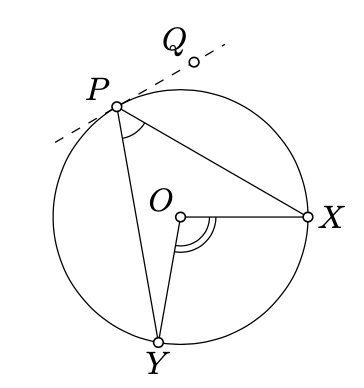
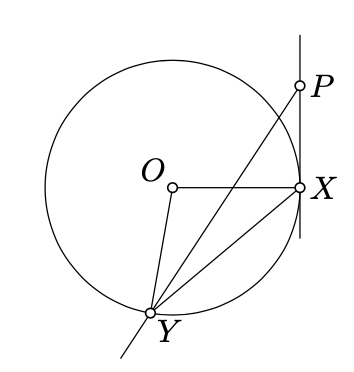
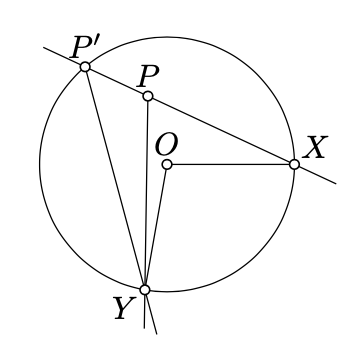
the "only if" part. Let \((PQ)\) be the tangent line to \(\Gamma\) at \(P\). By Theorem 9.1.1,
\(2 \cdot \measuredangle QPX \equiv \measuredangle POX\), \(2 \cdot \measuredangle QPY \equiv \measuredangle POY.\)
Subtracting one identity from the other, we get 9.2.1.
"If" part. Assume that 9.2.1 holds for some \(P \not\in \Gamma\). Note that \(\measuredangle XOY \ne 0\). Therefore, \(\measuredangle XPY \ne 0\) nor \(\pi\); that is, \(\measuredangle PXY\) is nondegenerate.
The line \((PX)\) might be tangent to \(\Gamma\) at the point \(X\) or intersect \(\Gamma\) at another point; in the latter case, suppose that \(P'\) denotes this point of intersection.
In the first case, by Theorem 9.1, we have
\(2 \cdot \measuredangle PXY \equiv \measuredangle XOY \equiv 2 \cdot \measuredangle XPY.\)
Applying the transversal property (Theorem 7.3.1), we get that \((XY) \parallel (PY)\), which is impossible since \(\triangle PXY\) is nondegenerate.
In the second case, applying the "if" part and that \(P, X\), and \(P'\) lie on one line (see Exercise 2.4.2) we get that
\(\begin{array} {rcl} {2 \cdot \measuredangle P'PY} & \equiv & {2 \cdot \measuredangle XPY \equiv \measuredangle XOY \equiv} \\ {} & \equiv & {2 \cdot \measuredangle XP'Y \equiv 2 \cdot \measuredangle XP'P.} \end{array}\)
Again, by transversal property, \((PY) \parallel (P'Y)\), which is impossible since \(\triangle PXY\) is nondegenerate.
Let \(X, X', Y\), and \(Y'\) be distinct points on the circle \(\Gamma\). Assume \((XX')\) meets \((YY')\) at a point \(P\). Show that
(a) \(2 \cdot \measuredangle XPY \equiv \measuredangle XOY + \measuredangle X'OY'\);
(b) \(\triangle PXY \sim \triangle PY'X'\);
(c) \(PX \cdot PX' = |OP^2 - r^2|\), where \(O\) is the center and \(r\) is the radius of \(\Gamma\).
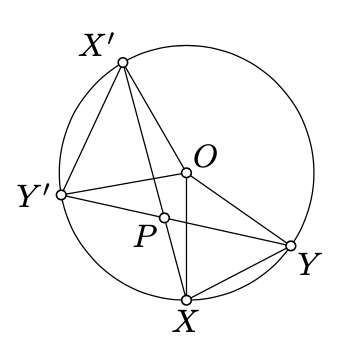
(The value \(OP^2 - r^2\) is called the power of the point \(P\) with respect to the circle \(\Gamma\). Part (c) of the exercise makes it a useful tool to study circles, but we are not going to consider it further in the book.)
- Hint
-
(a) Apply Theorem \(\PageIndex{1}\) for \(\angle XX'Y\) and \(\angle X'YY'\) and Theorem 7.4.1 for \(\triangle PYX'\).
(b) If \(P\) is inside of \(\Gamma\) then \(P\) lies between \(X\) and \(X'\) and between \(Y\) and \(Y'\) in this case \(\angle XPY\) is vertical to \(\angle X'PY'\). If \(P\) is outside of \(\Gamma\) then \([PX) = [PX')\) and \([PY) = [PY')\). In both cases we have that \(\measuredangle XPY = \measuredangle X'PY'\).
Applying Theorem \(\PageIndex{1}\) and Exercise 2.4.2, we get that
\(2 \cdot \measuredangle Y'X'P \equiv 2 \cdot \measuredangle Y'X'X \equiv 2 \cdot \measuredangle Y'YX \equiv 2 \dot \measuredangle PYX.\)
According to Theorem 3.3.1, \(\angle Y'X'P\) and \(\angle PYX\) have the same sign; therefore \(\measuredangle Y'X'P = \measuredangle PYX\). It remains to apply the AA similarity condition.
(c) Apply (b) assuming \([YY']\) is the diameter of \(\Gamma\).
Three chords \([XX']\), \([YY']\), and \([ZZ']\) of the circle \(\Gamma\) intersect at a point \(P\). Show that
\(XY' \cdot ZX' \cdot YZ' = X'Y \cdot Z'X \cdot Y'Z.\)
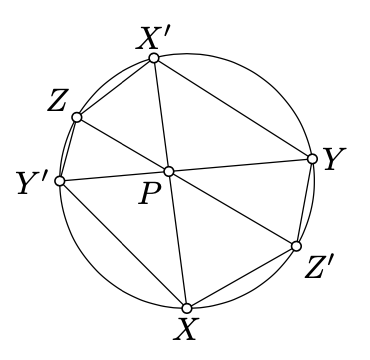
- Hint
-
Apply Exerciese \(\PageIndex{1} b three times.
Let \(\Gamma\) be a circumcircle of an acute triangle \(ABC\). Let \(A'\) and \(B'\) denote the second points of intersection of the altitudes from \(A\) and \(B\) with \(\Gamma\). Show that \(\triangle A'B'C\) is isosceles.

- Hint
-
Let \(X\) and \(Y\) be the foot points of the altitudes from \(A\) and \(B\). Suppose that \(O\) denotes the circumcenter.
By AA condition, \(\triangle AXC \sim \triangle BYC\). Then
\(\measuredangle A'OC \equiv 2 \cdot \measuredangle A'AC \equiv - 2 \cdot \measuredangle B'BC \equiv - \measuredangle B'OC.\)
By SAS, \(\triangle A'OC \cong \triangle B'OC\). Therefore, \(A'C = B'C\).
Let \([XY]\) and \([X'Y']\) be two parallel chords of a circle. Show that \(XX' = YY'\).
Watch “Why is pi here? And why is it squared? A geo- metric answer to the Basel problem” by Grant Sanderson. (It is available on YouTube.)
Prepare one question.


